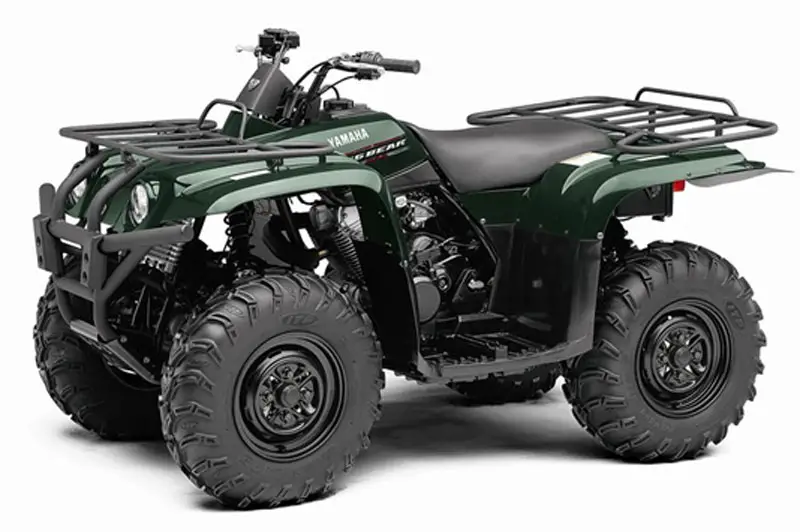As you may know, Yamaha has a reputation for building reliable and durable ATVs and dirtbikes, among other vehicles. The company also reportedly has a vast number of devoted customers. To satisfy their consumers more, Yamaha released their one-of-a-kind ATV at the beginning of the year 2000, and to their dismay, it ended the series in 2012. While it lasted, Yamaha’s Big Bear 400 has impacted the consumers’ lives. That is why it is one of the most beloved ATVs by Yamaha ever. The stated ATV was derived from the prior models of 1997 and 1998, which equally served the consumers as Yamaha’s Big Bear 400. To know more about its specs and what made Big Bear this renowned, continue reading this article. There are loads in store for you!

How Much is a Yamaha Big Bear 400?
The average price of a Yamaha Big Bear 400 reportedly ranges from $5,450 to $6,800. However, these prices could decrease or increase depending on the ATV’s appearance and the year it was released.
Often compared to a Yamaha Wolverine, Big Bear 400’s worth still holds a good chunk of value even though the series was a decade old and the company abandoned it. The exact price of the Yamaha Big Bear 400 depends on the ATV’s condition or the model in which the ATV was released. As per the recently reported purchases, the cost of a standard Big Bear 400 is estimated to be initiated from $5,399 to $6,599. On the other hand, the retail value of a typical Big Bear 400 is around $1,175 and $4,050, whereas the price of the ATV when trading in a dealership is an estimated $1,510. Above all Yamaha’s Big Bears, the Camo-styled ATVs are the most expensive, costing almost $7,000. The figures heavily depend on which model you intend to buy and how well-kept the vehicle is.
What Years Did Yamaha Make the Big Bear 400?
Yamaha started making its Big Bear 400 series in 2000 but stopped making ATVs in 2012 after over a decade of production.
As stated above, Yamaha established their specific Big Bear 400 in 2000, when the ATV gained much popularity among fanatics, experts, and users. If you are a massive fan of ATVs and dirt bikes, you would know what passion enthusiasts hold for branded and one-of-a-kind ATVs like Yamaha’s Big Bear 400. Unfortunately, to many users’ and experts’ dismay, Yamaha quit manufacturing such Big Bear 400 ATVs in 2012. Even though the corporation or incorporation manufactures the stated ATV, the vehicle is still reasonably priced in retail stock. If you are almost a decade late buying a Yamaha Big Bear 400, you can easily purchase it from a seller or retailer stock.
Why Did Yamaha Discontinue the Big Bear 400?
Due to frequent crash hazards and accidents, Yamaha stopped manufacturing Big Bear 400 ATVs in early 2012.
In the light of those written above, you and I can see how many users were disheartened when Yamaha called it quits on the Big Bear 400 series. Furthermore, it would lead you to question why on earth Yamaha decided to stop on an ATV series that was doing nothing but blooming in the market. What led them to make such a drastic decision? To answer your query authentically, Yamaha reported that during the end of the series, there were many reports of crash hazards regarding the Big Bear 400. Many accidents and roadkills were reported, after which Yamaha decided to end the reckless dirt biking and declared to abandon the Big Bear 400 series. Sadly, the engine Yamaha created for the Big Bear 400 in the day is now terribly high in demand in today’s market. Disheartening, right?
How Fast is a Yamaha Big Bear 400?
Yamaha’s Big Bear 400’s estimated average speed is 45 mph, whereas its top speed is reported to be 52 mph.
The ATV, Big Bear 400, brought into existence by Yamaha, does have a specific high-speed limit. Considering the ATV was meant to thrive on the rigged hills or roads, the reported standard speed of the Big Bear 400 is 45 mph. That is, however, the average of the Big Bear 400. The top speed ever said of any Big Bear 400 was 52 mph, but with some tweaking, the speed can go up to 55 mph for other users. This is considerably speedy as these dirt bikes are usually taken up to trek in mountains or forests at a very high speed.
What Year Was Big Bear 400?
Yamaha’s Big Bear started in 2000 and gained many devoted followers. However, Yamaha abandoned the series in 2012.
According to previously mentioned above, Yamaha’s Big Bear 400 was established in the initial year of the 21st century, the year 2000, and sadly ended in 2012 after some reports of crashes and accidents related to Big Bear 400.
How Wide is a Yamaha Big Bear 400?
The width of Yamaha’s Big Bear 400 quad series is around 79 x 43.7 x 46.1 inches.
This article has now frequently stated how efficient these Yamaha’s quads are, with their 52 mph top speed and versatile engine and appearance. You may be left wondering what made these vehicles support such features. Yamaha’s Big Bear 400 seemingly has a width as it efficiently helps the heavy engine, drive train, body structure, and the driver himself. As per the latest stats about Yamaha’s Big Bear 400, the ATV seemingly holds a total dimension of 79 x 43.7 x 46.1 inches, with its ground clearance stated to be 9.65 inches and the turning radius around 124 inches. Furthermore, the wheelbase of the stated ATV is pronounced to be 48.4 inches.
Where is the VIN Number Located on a Yamaha Big Bear 400?
The VIN on your Yamaha Big Bear 400 is either on the left of your vehicle’s front tire or near the lower frame rail of your ATV’s underside.
Are you left stranded on simply finding the VIN on your Yamaha Big Bear 400? Do not worry, as this article is here to help. To locate the VIN plate on your Yamaha Big Bear 400, look under the front tire on the left side of your vehicle’s frame. Look underneath the engine at the lower frame rail if it isn’t there. Your VIN is a 17-digit number identifying and providing information about your Big Bear.
Where is the serial number of a Yamaha four-wheeler?
Located on the back of your Big Bear 400 or on the left of the ATV’s front tire, you can easily find the serial or the VIN attached to the vehicle.
Serial numbers and VIN PINs are the same, so according to the above, the serial number of your Yamaha quad can be located on the quad’s front tire’s left side or stamped on the backside of your vehicle’s frame.
What Oil Does a Yamaha Big Bear 400 Take?
Yamaha’s Big Bear 400 takes the Tusk 4-Stroke Oil Change Kit Yamalube All Purpose 10W-40, which was put together just for the vehicle. The oil is necessary for the car to provide promising results and can run up to miles for hours.
The quad, Yamaha’s Big Bear 400, takes a specific oil to support its versatile and durable engine. The oil in question is Tusk Racing oil, which the company produced just for the sake of Yamaha’s ATVs or quads. Tusk 4-Stroke Oil Change Kit Yamalube All Purpose 10W-40 would be required to feed to your Big Bear 400, after which you could see the efficient results of your durable quad.
How Much Does a 1998 Yamaha Big Bear Weigh?
The total mass of Yamaha’s 1998 Big Bear quad was reportedly around 476 pounds.
Above, you learn all about the specs of a typical Yamaha Big Bear 400. Still, as the article proceeds, you will learn about earlier Big Bear modelers of Big Bear 400 that were released in 1997 and 1998, named Yamaha Big Bear in 1997 and 1998, respectively. The Big Bear 400 was derived from them, as these old models were not far behind the Big Bear 400 in terms of performance and engine. Yamaha Big Bear 1998 specifically was constructed with a profound engine. The 1998 Yamaha Big Bear weighed 476 pounds wet and measured 75.4 inches long, 45.9 inches wide, and 44.5 inches tall. The ATV had a 33.5-inch seat height, a 47.6-inch wheelbase, and a 7.1-inch ground clearance. With a backup tank of 0.3 gallons, the fuel tank could hold 2.6 gallons.
How Many Gears Does a Yamaha Big Bear 400 Have?
Yamaha released the quad of Big Bear 400 with a 5-speed gearbox, which enables the vehicle to drive at high speed over rocky terrains and rough pathways, ensuring the ATV and the driver’s safety.
In addition to all the beneficial factors of the Yamaha Big Bear 400, it has installed a profound set of gears. The 2008 Yamaha Big Bear 400 gets even better with the IRS option. With independent rear suspension, this ATV can support terrain roughness even better, maximizing stability and carrying rider and gear further into the wilderness. Even for the inexperienced rider, a semi-automatic transmission with a 5-speed gearbox and automated clutch makes things simple and enjoyable.
What Size is a Yamaha Big Bear 400?
Yamaha Big Bear 400’s maximum size is 79 x 43.7 x 46.1 inches, including the vehicle’s width, breadth, height, and overall dimensions.
The exact size of a standard Yamaha Big Bear 400 is already noted in this reading. To state the written again, Yamaha’s Big Bear 400 quad is 79 x 43.7 x 46.1 inches. The indicated size of Big Bear 400 ensures the vehicle’s engine is installed suitably, allowing a spacious area for the driver to place himself accordingly.
In a nutshell, in their manufacturing history, Yamaha has never failed to produce top-notch ATVs and four-wheeler quads, and the Big Bear 400 is a brief example of this statement. This article includes all the specs of Yamaha’s Big Bear 400, including the size and type of oil the vehicle consumes. If you are looking forward to buying your Yamaha Big Bear 400, then I am sure this read was of great help.
